When it comes to precision, efficiency, and long-term reliability, digital industrial flow meters stand far above their mechanical counterparts. Regardless of the medium you're monitoring, be it water, gas, oil, high-viscosity liquids, or corrosive chemicals, choosing the right digital flow meter ensures accurate readings and optimal performance in your industrial operations.
In this guide, we’ll break down the most common
types of digital flow meters, compare their features, and help you understand what to look for before making your purchase.
Types of Digital Flow Meters (and How They Compare)
There are several types of digital flow meters used in industrial settings. Each one works on a different principle and suits specific applications. Here's a quick overview:
Electromagnetic Flow Meter
Magnetic flow meters, also referred to as electromagnetic flow meter, mag meters, measure the voltage that a liquid produces as it flows through a magnetic field to calculate the fluid flow rates.
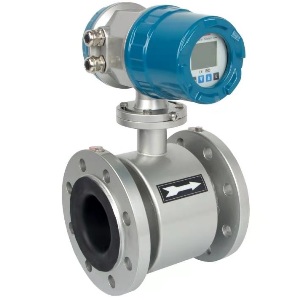 Best for: Conductive liquids (e.g., water, acid, chemical,milk, slurry, wastewater)
Best for: Conductive liquids (e.g., water, acid, chemical,milk, slurry, wastewater)
How it works: Measures flow using Faraday’s law of electromagnetic induction
Pros: No moving parts, high accuracy, low pressure drop
Cons: Cannot be used for non-conductive fluids (like oil or gas)
Ultrasonic Flow Meter
An ultrasonic digital flow meter is a type of flow measurement device that uses ultrasonic sound waves to determine the flow rate of a fluid—usually liquids, and sometimes gases—inside a pipe.
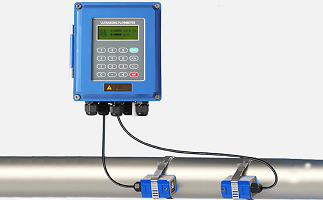 Best for: Clean liquids in large pipes, most time can work on clean water.
Best for: Clean liquids in large pipes, most time can work on clean water.
How it works: Uses ultrasonic waves to measure the velocity of flow
Pros: Non-intrusive (clamp-on models), minimal maintenance
Cons: Performance can be affected by bubbles or solids in the liquid
Coriolis Flow Meter
Unlike many other flow meters that measure volume, Coriolis meters directly measure mass flow rate of a fluid, which is especially useful when precision is critical.
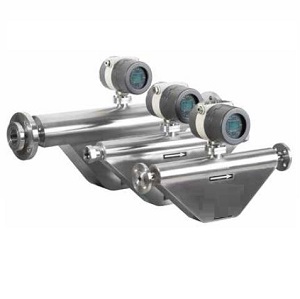 Best for: High-accuracy measurement of liquids and gases, it is the best accuracy flow meters.
Best for: High-accuracy measurement of liquids and gases, it is the best accuracy flow meters.
How it works: Detects changes in mass flow via vibration
Pros: Extremely accurate, measures both mass flow rate and total flow rate, temperature and density
Cons: Expensive
Vortex Flow Meter
A Vortex Digital Flow Meter is a type of flow meter that measures the flow rate of liquids, gases, or steam by detecting vortices (swirling patterns) created when the fluid flows past a bluff body (a fixed obstruction in the flow path).
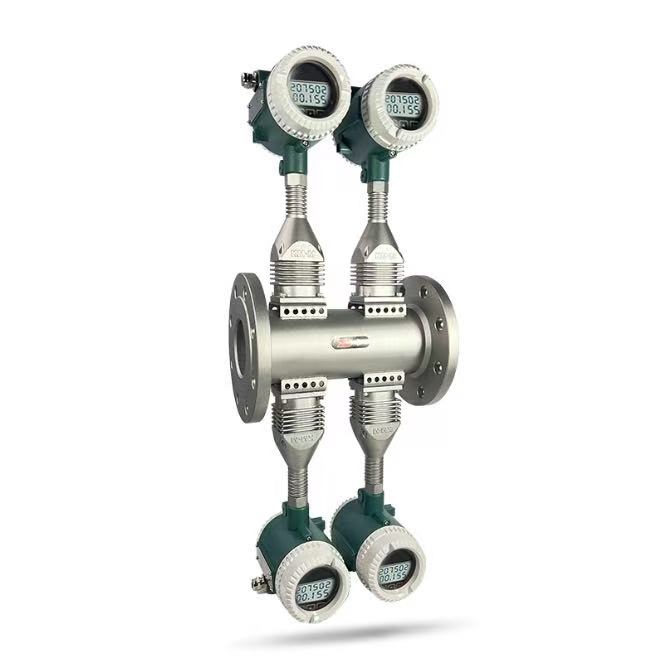 Best for: Steam, gas, and some liquids
Best for: Steam, gas, and some liquids
How it works: Measures vortices shed by an obstruction in the flow
Pros: No moving parts, good for high-temperature and high-pressure applications, normally used for steam measurement.
Cons: Less accurate for low flow rates and high viscosity liquid measurement.
Thermal Mass Flow Meter
A Thermal Mass Flow Meter measures the actual mass flow of gases using heat transfer, providing accurate readings unaffected by temperature or pressure changes—unlike meters that measure volume or velocity.
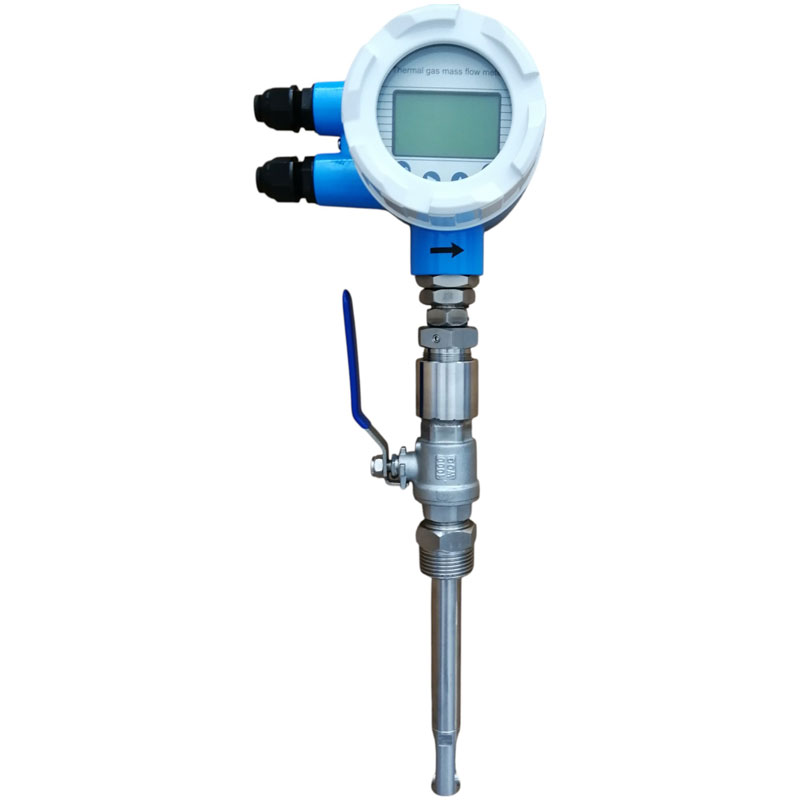 Best for: Gas measurement (especially air, nitrogen, biogas,CO2, LPG or natural gas)
Best for: Gas measurement (especially air, nitrogen, biogas,CO2, LPG or natural gas)
How it works: Measures heat dissipation as gas flows past a heated sensor
Pros: Direct mass flow reading, good for low flow rates, can even measure gas at vacuum environment.
Cons: Not suitable for liquids or high pressure gas measurement
Comparison Summary Table
|
Digital Flow Meter Type
|
Best Use Case
|
Compatible Fluids
|
Accuracy
|
Applications
|
Advantages
|
Limitations
|
|
Vortex Flow Meter
|
Steam, gas, and liquid flow measurement
|
Liquids, gases, steam
|
±1% of reading
|
Steam boilers, chemical processing, HVAC systems
|
Handles high temperatures and pressure, durable, low maintenance
|
Less accurate at low flow rates
|
|
Electromagnetic Flow Meter (Mag Meter)
|
Measuring conductive liquids
|
Water, slurry, chemicals, wastewater
|
±0.5% of reading
|
Water treatment, food processing, chemical plants
|
Highly accurate, no pressure loss, long service life
|
Cannot measure non-conductive fluids (e.g., oil, air, gas)
|
|
Ultrasonic Flow Meter
|
Clamp-on and inline flow monitoring
|
Clean water
|
±1% or better
|
Energy monitoring, water systems, pipeline flow
|
Non-invasive (clamp-on), no flow disruption
|
Accuracy may vary with pipe and fluid conditions
|
|
Coriolis Flow Meter
|
High-accuracy mass flow for liquids and gases
|
Liquids, gases (including high viscosity)
|
±0.1% or better
|
Oil & gas, pharmaceutical, food and beverage
|
Measures mass flow directly, extremely accurate
|
High cost, sensitive to vibration
|
|
Thermal Mass Flow Meter
|
Low flow gas measurement
|
Air, nitrogen, natural gas, CO₂
|
±1-2% of reading
|
HVAC systems, gas leak detection, cleanrooms
|
Ideal for low gas flow, high sensitivity
|
Not suitable for liquids or dirty gases
|
Key Factors to Consider When Choosing a Flow Meter
Now that you’re familiar with the different types of digital flow meters and how they work, the next step is carefully evaluate several critical factors and align them with the appropriate flow meter type.
✅ Fluid Type
Is it a liquid or gas? Is it clean, dirty, conductive, or viscous? This will narrow down your options quickly. If the liquid is with high viscosity, like flow measurement of molasses, asphalt, fructose, and resin, you also need to tell your
flow meter suppliers the fluids viscosity information .
✅ Flow Range
Assess the process’s minimum and maximum volumetric flow rates against the flow meter’s specified turndown ratio and operating range. Accurate measurement requires the flow to remain within the meter’s calibrated range. For flow rates below the meter’s lower detection limit, an ultra-low flow or micro flow meter should be selected. For flow rates exceeding the upper range, consider upsizing the flow meter or increasing the nominal pipe diameter to prevent measurement inaccuracies and maintain Reynolds number suitability.
✅ Accuracy Requirements
Do you need precise measurement or just a general idea of flow? Coriolis meters offer the highest accuracy, while vortex meters are typically “good enough” for many processes. For example, when fuel oil and LPG measurement involve trade measurement, we will choose CORIOLIS flowmeter, but for many boiler equipment, we only need a vortex flowmeter to obtain steam consumption.
✅ Installation Conditions
Think about pipe size, straight run requirements, available space, and environmental conditions (temperature, pressure, vibration).
✅ Output and Connectivity
Most digital flow meters offer various outputs like 4-20 mA, Modbus, frequency, profibuds DP or pulse. Choose based on your control system or SCADA integration.
✅ Maintenance and Total Cost
Digital meters generally require less maintenance than mechanical ones, but some high-end types (like Coriolis) may involve higher upfront costs.
Choosing the right digital industrial flow meter doesn't have to be overwhelming. Start by identifying your application needs—fluid type, flow range, and accuracy—and then match them to the most suitable meter.
Whether you're measuring water, gas, steam, or chemicals, there's a digital solution that offers better efficiency, reliability, and data-driven performance.
Need help choosing the right flow meter?
Contact our experts from silverinstruments.com for a free consultation — we’ll help you find the perfect match for your industrial project.
Contact Us Now
 Best for: Conductive liquids (e.g., water, acid, chemical,milk, slurry, wastewater)
Best for: Conductive liquids (e.g., water, acid, chemical,milk, slurry, wastewater) Best for: Clean liquids in large pipes, most time can work on clean water.
Best for: Clean liquids in large pipes, most time can work on clean water. Best for: High-accuracy measurement of liquids and gases, it is the best accuracy flow meters.
Best for: High-accuracy measurement of liquids and gases, it is the best accuracy flow meters. Best for: Steam, gas, and some liquids
Best for: Steam, gas, and some liquids Best for: Gas measurement (especially air, nitrogen, biogas,CO2, LPG or natural gas)
Best for: Gas measurement (especially air, nitrogen, biogas,CO2, LPG or natural gas)